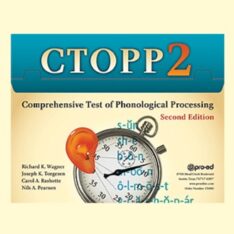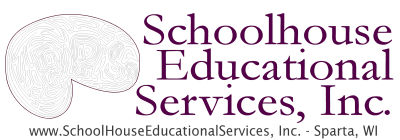Comprehensive Test of Phonological Processing-Second Edition – CTOPP-2
Description
The CTOPP-2 has four principal uses:
- Identify individuals who are significantly below their peers in important phonological abilities,
- Determine strengths and weaknesses among developed phonological processes
- Document individuals’ progress in phonological processing as a consequence of special intervention programs
- To serve as a measurement device in research studies investigating phonological processing.
The 1st Edition of the Comprehensive Test of Phonological Processing (CTOPP) was published in 1999 to meet the need for an assessment of reading-related phonological processing skills. Since its initial publication, the CTOPP has been popular with professionals in psychology and education. It has been used in many studies of reading and phonological processing in both typical and clinical populations. The extent of its widespread adoption and usage is evident from the results of a recent search of the PsychInfo database for research studies using the terms Comprehensive Test of Phonological Processing or CTOPP. The query returned 4,287 results.
Authors: Richard Wagner, Joseph Torgesen, Carol Rashotte, Nils Pearson
Purpose: Assess reading-related phonological processing skills
Ages: 4 – 24 years
Administration: Individual
Published: 2013
Administration Time: 40 minutes
Qualification Level B
*COMPLETE CTOPP-2 KIT INCLUDES: Examiner’s Manual, 25 Examiner Record Booklets for ages 4 through 6, 25 Examiner Record Booklets for ages 7 through 24, Picture Book, and online access to supplemental material, all in a sturdy storage box.
| Qualification Level: | B | Click For Qualification Level Information |
CTOPP-2 Subtests
- Elision measures the ability to remove phonological segments from spoken words to form other words.
- Blending Words measures the ability to synthesize sounds to form words.
- Sound Matching measures the ability to select words with the same initial and final sounds.
- Phoneme Isolation measures the ability to isolate individual sounds within words.
- Blending Nonwords measures the ability to synthesize sounds to form nonwords.
- Segmenting Nonwords measures the ability to segment nonwords into phonemes.
- Memory for Digits measures the ability to repeat numbers accurately.
- Nonword Repetition measures the ability to repeat nonwords accurately.
- Rapid Digit Naming measures the ability to rapidly name numbers.
- Rapid Letter Naming measures the ability to rapidly name letters.
- Rapid Color Naming measures the ability to rapidly name colors.
- Rapid Object Naming measures the ability to rapidly name objects.
CTOPP-2 Composites
- Phonological Awareness Composite Score (PACS) comprises the standard scores of three subtests-Elision, Blending Words, and Sound Matching-for 4 through 6 year olds, and Elision, Blending Words, and Phoneme Isolation for 7through 24 year olds. The PACS represents the examinee’s awareness of and access to the phonological structure of oral language.
- Phonological Memory Composite Score (PMCS) comprises the standard scores of two subtests -Memory for Digits and Nonword Repetition-for all individuals. The PMCS represents the examinee’s ability to code information phonologically for temporary storage in working or short-term memory.
- The Rapid Symbolic Naming Composite Score (RSNCS) comprises the standard scores of two subtests-Rapid Digit Naming and Rapid Letter Naming-for all individuals. The RSNCS measures the examinee’s ability to include efficient retrieval of phonological information from long-term or permanent memory and execute a sequence of operations quickly and repeatedly.
- Rapid Non-Symbolic Naming Composite Score (RNNCS) comprises the standard scores of two subtests-Rapid Color Naming and Rapid Object Naming and offers an alternative for young children, ages 4 through 6 year olds, not familiar with letters and numbers. The RNNCS measures the examinee’s ability to include efficient retrieval of phonological information from long-term or permanent memory and executing a sequence of operations quickly and repeatedly using objects and colors.
- The Alternate Phonological Awareness Composite Score (APACS), an alternate composite for measuring phonological awareness is available for 7 through 24 year olds. It is formed by combining the scaled scores from Blending Nonwords and Segmenting Nonwords. The APACS measures the examinee’s phonological awareness exclusively with nonwords.
Technical Information
Reliability of the CTOPP-2 subtests and composites was demonstrated by average internal consistency coefficients presented for the subtests that exceed .80 for all except Nonword Repetition with an average alpha of .77. The average internal consistency coefficients for the composites were all .85 or higher, a highly desirable level for reliability. Validity of the CTOPP-2 subtests and composites was demonstrated by correlations to measures directly related to the constructs measured by the CTOPP-2. The averaged coefficients for the subtests range from .49 (moderate) to .84 (very large); those for the composites range from .65 (large) to .76 (very large) in magnitude.
| Comprehensive Test of Phonological Processing, 2 Ed. (CTOPP) | ||
| CTOPP2KIT | CTOPP-2 Complete Kit | $393.00 |
| COMPLETE CTOPP-2 KIT INCLUDES: Examiner's Manual, 25 Examiner Record Booklets for ages 4 through 6, 25 Examiner Record Booklets for ages 7 through 24, Picture Book, and online access to supplemental material, all in a sturdy storage box. | ||
| CTOPP2EM | CTOPP-2 Examiner's Manual | $122.00 |
| CTTOP2PB | CTOPP-2 Picture Book | $107.00 |
| CTTOP2RB1 | CTOPP-2 Examiner Record Booklet for Ages 4-6 (25 Pack) | $83.00 |
| CTTOP2RB2 | CTOPP-2 Examiner Record Booklet for Ages 7-24 (25 Pack) | $83.00 |
Purchase Orders:
-

CTOPP-2 Examiner Record Booklet for Ages 7-24 25 Pack
$87.00 -

CTOPP-2 Examiner Record Booklet for Ages 4-6 25 Pack
$87.00 -

Comprehensive Test of Phonological Processing 2nd Ed Picture Book
$107.00 -

Comprehensive Test of Phonological Processing 2nd Ed Examiner’s Manual
$128.00 -

Comprehensive Test of Phonological Processing, 2nd Ed Complete Kit CTOPP-2
$399.00
